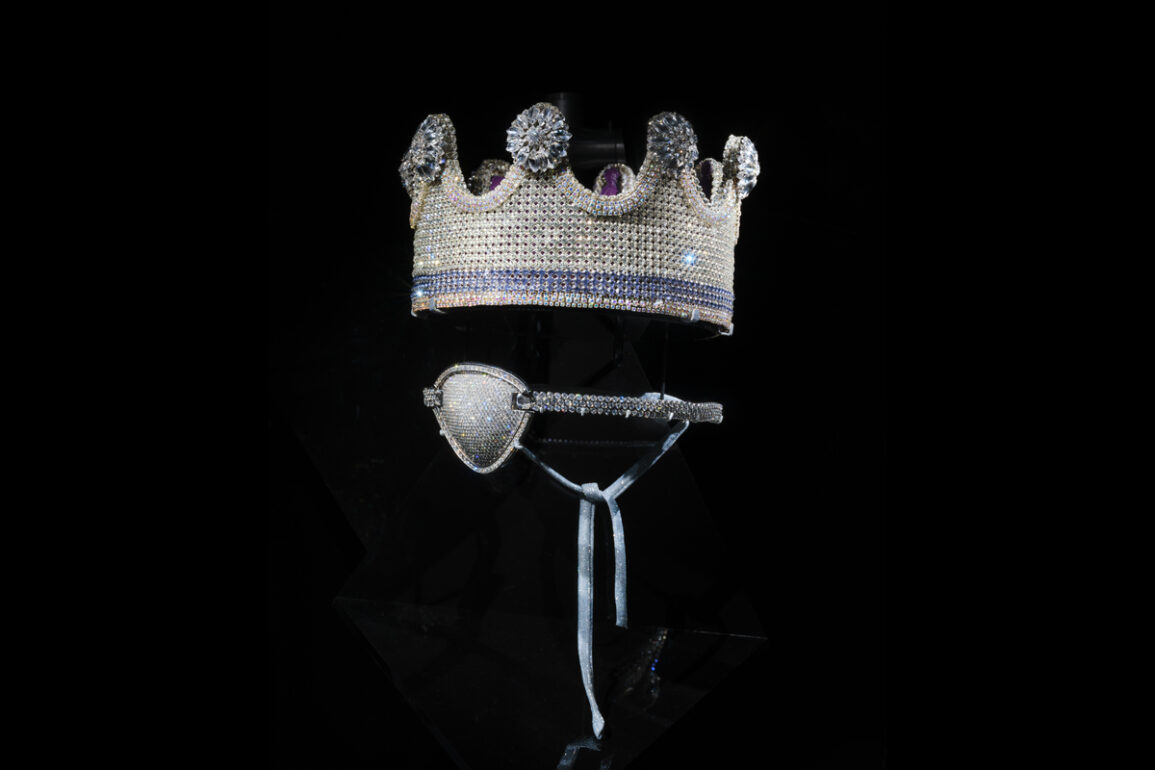It is a rite of passage for many young Black girls to receive their first piece of gold jewelry. It serves as a keepsake of their family, of where they come from, of who they are, and it typically becomes a staple in their own jewelry collections. Many people across the Black diaspora recognize jewelry as a symbol of identity as well as a signifier of wealth and success. While gifting jewelry has been practiced for centuries across many cultures, today, some of the most iconic and coveted jewelry comes directly from the influence of hip-hop culture, inspired both by the genre’s most famous artists and everyday people.
The recently opened exhibition “Ice Cold: An Exhibition of Hip-Hop Jewelry” at the American Museum of Natural History in New York (on view through next January) aims to chart this story, unraveling jewelry’s undeniable role in how early hip-hop artists and their audiences chose to present themselves in a world that refused to accept and acknowledge them and how that five-decade legacy continues to impact contemporary fashion, style, and representations of wealth and status, especially in the Black community.
Curated by Vikki Tobak, a journalist and author of a book that lends the exhibition its title, with record executive Kevin “Coach K” Lee and filmmaker Karam Gill, “Ice Cold” features iconic pieces worn and designed by hip-hop pioneers since the 1970s, including Roxanne Shanté’s nameplate necklace, Notorious B.I.G.’s Jesus Piece, and Tyler the Creator’s Bellhop Chain.
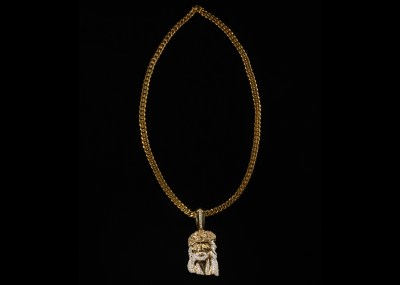
The Notorious B.I.G. commissioned this Jesus pendant in the mid-1990s from Tito Caicedo of Manny’s New York. Caicedo made three copies for Biggie, all cast from the same mold as the artist’s proof shown here.
Photo Alvaro Keding/©AMNH
Located in the museum’s new Halls of Gems and Minerals, the exhibition is a mesmerizing display of 68 pieces of legendary chains, rings, grills, and more. Set to a soundtrack of tracks by Queen Latifah, Biz Markie, and Outkast, among others, the display is accompanied by photographs of hip-hop’s “iciest” artists from Tupac to Gucci Mane, Missy Elliot to Cardi B. With section titles like “Hey Young World,” “In Our Lifetime,” and “Code of the Streets,” the exhibition aims to track hip-hop’s evolution, showcasing the jewelry that best defined each distinct period.
“Adorning ourselves and presenting ourselves to the world is a very human thing,” Tobak told ARTnews. “When it comes specifically to hip-hop culture and Black culture, it takes on all these additional layers. Hip-hop developed its very own jewelry language that used a lot of elements of the music and things that inform the music, like remixing, customization, and having something that nobody else has. All of that, hip-hop did bigger and better than anyone.”
T-Pain’s “Big Ass Chain,” for example, is a testament to this idea: weighing more than 10 pounds, it is beset with nearly 200 carats of diamonds. As is Erykah Badu’s 22-karat gold Ma’at grill set, inspired by the eponymous ancient Egyptian goddess, or even Slick Rick’s trademark platinum-and-diamond crown and eyepatch by Tanya Jones of Lucki Crowns. Extravagant and expensive jewelry, custom-made and designed for hip-hop artists, showed audiences that they were deserving and capable of reaching unimaginable wealth and success, regardless of their backgrounds.

Installation view of “Ice Cold: An Exhibition of Hip-Hop Jewelry,” 2024–25, at American Museum of Natural History, New York.
Photo Alvaro Keding/©AMNH
“I think a lot of hip-hop artists and people in the culture refer to jewelry as a trophy,” Gill said. “I think it’s a form of expression. It’s a celebration. It’s a storytelling device. This is something that’s prevalent throughout cultures around the world. And I think hip-hop, as it does with everything really, just kind of took that and expanded what it could be artistically, visually, and symbolically.”
And even though hip-hop culture, popularized by historically underrepresented Black and Latinx communities, expanded the possibilities of jewelry, Gill, who directed a related four-past documentary also titled Ice Cold, said that double standards imposed onto people of color have affected how hip-hop jewelry has been perceived, even today.
“Whether it’s hip-hop jewelry, or it’s Elizabeth Taylor’s collection, jewelry is used for a variety of purposes,” he said. “It’s used for projecting success. It’s used for celebrating moments and for unifying groups of people. And those common usages of jewelry are consistent across the world whether you’re white, Black, or Brown.”
“Ice Cold” also acknowledges the contributions of jewelers who have become hip-hop legends in their own right. Pieces by giants like Ben Baller and Jacob “The Jeweler” Arabo glint under spotlights behind tall glass cases, frozen in time. Their collaborative partnerships with hip-hop artists gives further evidence of how jewelry and hip-hop aesthetics evolved hand in hand, always with a demand to be seen.
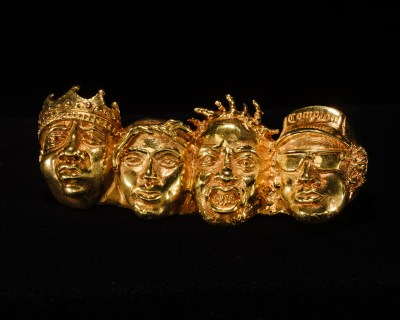
Johnny Nelson, Fingers of Def four-finger ring, 2018, from “Mount Rushmore” series, depicting, from left: Biggie, Tupac, Ol’ Dirty Bastard, and Easy-E.
Photo Alvaro Keding/©AMNH
Brooklyn-raised jeweler Johnny Nelson, whose pieces are featured in “Ice Cold,” said he sees his work as a love letter to the symbiotic relationship between jewelry, hip-hop, and the Black diaspora. His 2018 Fingers of Def Four-Finger Ring, depicting Biggie, Tupac, Ol’ Dirty Bastard, and Easy-E in 14-karat gold, pay tribute to some of the genre’s most influential artists as part of his “Mount Rushmore” collection of multi-finger rings, elevated forms of brass knuckle weapons and now symbols of power in hip-hop,.
Nelson’s appreciation for hip-hop music and culture can also be seen in works like his 14-karat gold Women in Hip-Hop and R&B Necklace (2021), featuring Missy Elliott, Lauryn Hill, Beyoncé, Queen Latifah, Mary J. Blige, and Erykah Badu. (Related pieces by Nelson including necklaces, rings, and hair adornments, were featured in designer Kerby Jean-Raymond’s 2019 Pyer Moss “Collection 3” fashion show.)
“I feel like they all show their light in hip-hop in various ways and they all bring something different to the table,” Nelson said of the women featured in these pieces. “They’re all powerful in their own right, and they’re all legends.”

Johnny Nelson, Women in Hip-Hop and R&B Necklace, 2021, showing Missy Elliott, Lauryn Hill, Beyoncé, Queen Latifah, Mary J. Blige, and Erykah Badu.
Photo Alvaro Keding/©AMNH
A former hip-hop artist himself, Nelson was inspired by LL Cool J, among other artists, to create and wear his own jewelry. His dedication to his craft is rooted in an understanding that the connection between jewelry and Black communities is not simply a surface level mode of adornment. In a country that has historically and systematically oppressed Black people, denying them opportunities to generate or maintain generational wealth, Nelson views wearing jewelry as much as a daily ritual as a celebration of how much the community has overcome and continues to fight against.
“You gotta look like money to get money, even if you don’t have it,” he said. “You’ve got to act like you got some bread. It’s manifestation too. It’s our sign of showing up and showing out. It’s already in us.”
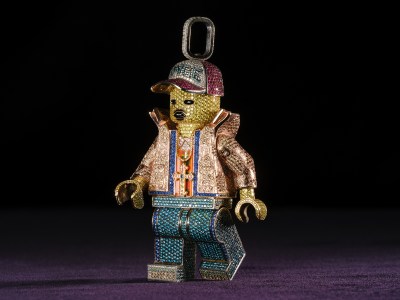
A Lego pendant, designed for A$AP Rocky by Alex Moss X Pavē, 2022.
Photo Alvaro Keding/©AMNH
Shirley Neal, author of the forthcoming book AfroCentric Style: A Celebration of Blackness & Identity in Pop Culture, believes that it’s important to trace this innate understanding of jewelry and its role in society to centuries-old African traditions.
“Like a lot of cultures, our African ancestors have adorned themselves with jewels as symbols of wealth for centuries,” she said. “I’m proud that many African American hip-hop artists are astute enough to look beyond the symbolism of jewelry as ‘bling bling,’ just to draw attention, or just as a measure of wealth. Instead, many see it as their birthright.”
Still, despite hip-hop’s contribution to the jewelry and fashion industries, there is a need for diversity among those who profit from the creation and sale of jewelry.
“The industry that I’m in wasn’t built for us,” Nelson said. “It takes from the culture because people buy from other people that don’t give back to our culture. We’re so used to being the consumers, so I think it’s good to show my people that we can produce also.”
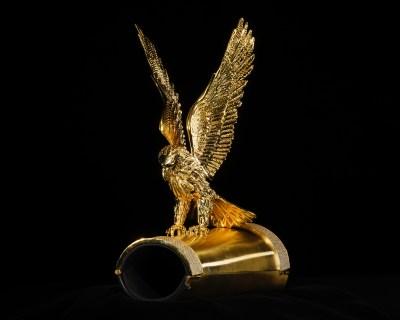
A 14-karat gold piece, designed for Ghostface Killah by Jason Arasheben, ca. 1990s.
Photo Alvaro Keding/©AMNH
Throughout hip-hop’s history, the culture’s founders were faced with adversity and rejection that drove them to succeed by any means necessary. From Ghostface Killah’s Eagle Bracelet to the famous Roc-A-Fella chain, to Public Enemy’s leather medallion, jewelry in hip-hop and among the Black diaspora represents more than money or pride. Instead, it is a symbol of perseverance and a tool for manifestation and a sense of self-determination.
“Jewelry is so much deeper and ingrained in the fabric of American society than we even realize,” Gill, the exhibition’s co-curator, said. “When you start to realize what it actually means to people outside of hip-hop, I think you can start to realize that it’s powerful.”
This post was originally published on this site be sure to check out more of their content.



